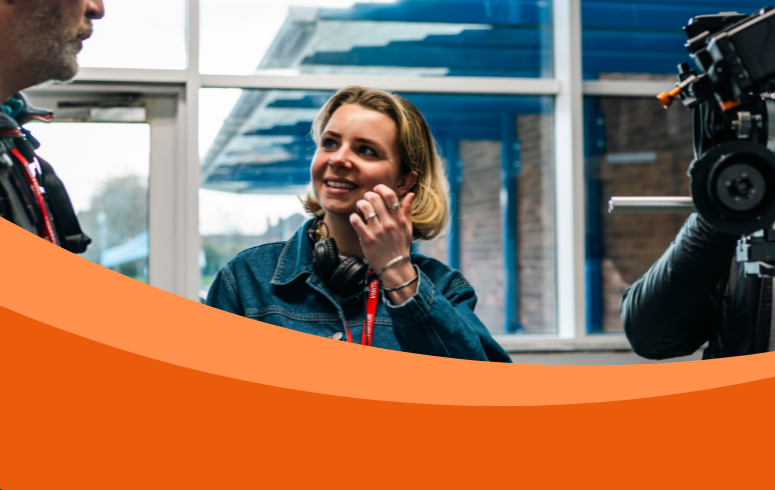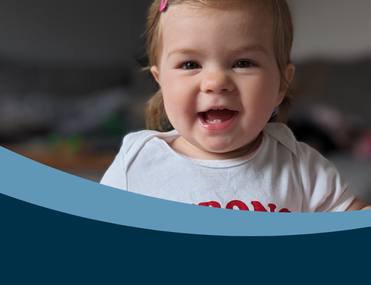“There's such a spectrum of deaf people, we're all different, but through them, I've begun to not only accept my deafness, but be proud of it.”
We have been given an insight into Holly Loach's journey towards her dream of working in television, and of finding her confidence as a deaf person championing deaf stories.
From being PA for founders at the award-winning production company Voltage TV, to working with Rose Ayling Ellis on the groundbreaking programme for BBC1, ‘Old Hands New Tricks’, to recently landing a new job at BBC’s flagship soap, Eastenders, Holly has been unstoppable in striving for her dream.
Holly Loach contracted meningitis at 14 months old. As a result, Holly lost her hearing and wears cochlear implants. As an imaginative child, Holly would get lost in creating characters and stories inspired by her favourite books. She believes this was the root of her passion for TV.
“TV is a simple and emotive mode of storytelling – I like how the visual aspect of it is powerful in showing, not telling. Working in TV is exciting because you get to meet all sorts of interesting people. It’s a privilege to find ways to tell people’s stories and their worlds on screen.”
Deaf representation on screen
Growing up, Holly didn’t see any deaf representation on screen. Furthered by her experiences going to mainstream school and growing up appearing ‘hearing’ she didn’t know many deaf people. Her understanding of deaf identity and culture was very limited.
“Stories were always a form of escapism for me, and I loved that, but it meant I never had a deaf role model, or knew what it meant to have deaf perspective in storytelling. Not having that representation undoubtedly impacted how I felt about my own deafness.”
It was when Holly started a career in TV as a PA, that struggling to advocate for her deafness took its toll: “I was very good at hiding my deafness, but it mean I couldn’t keep up in busy production meetings and hectic shoots. I would be exhausted at the end of every day to the point I thought this fast and loud TV world wasn’t for me.” But seeing Rose Ayling Ellis on Eastenders and Strictly changed everything.
Seeking deaf people in TV
“I started relentlessly seeking deaf people in TV. I emailed the deaf writer, Charlie Swinbourne, who worked on Rose’s character Frankie’s storyline on Eastenders, and hunted down a deaf script editor after I found the production company that was creating an ITV series featuring deaf actors.”
Holly was working in documentaries and had loved Rose’s BBC programme, ‘Signs For Change’, and had emailed Rogan Productions, hoping to work on their next project with Rose: “I had always been ashamed of my deafness, but after seeing Rose, I was beginning to realise that my life had been missing something. I started to become desperate to meet other deaf people in TV. I started asking myself, what was the ‘deaf way’ in programme making?”
Holly was thrilled to receive an offer from Rogan Productions to work as an Assistant Producer on their new show, 'Old Hands New Tricks' - a groundbreaking two part documentary for BBC One documenting a group of retirement village residents as they go on a journey to learn sign language.
Hearing loss
Hearing loss is high amongst the elderly population, contributing to loneliness and social isolation. Hearing aids are often proposed as the only solution, but evidence shows they’re not always effective, or there's simply stigma attached to wearing them. British sign language, the language close to the heart and identity to many people in the deaf community, offers a heartwarming and powerful alternative solution.
The expressiveness and openness inherent in deaf culture and BSL seems a brilliant counter to the social isolation connected to hearing loss, and Rose's radical experiment leads to extraordinary personal transformation in the residents. It is emotional and affecting to watch.
When Holly first joined the team, she was amazed by the spirit of the deaf people she worked with: "They all communicated exactly what they needed from the off. They had such a strong sense of who they were as a deaf person. I was almost intimidated at first, but then when I realised how communicating what you needed benefitted not just them, but everyone, I started to see how advocating for my needs was something powerful."
Using sign language
Over the weeks and months the crew worked together, everyone started using bits of sign language. Conversations between a mixed BSL, oral deaf and hearing team became seamless; it was extraordinary.
It became apparent that clear communication and turn taking was incredibly conducive for creative collaboration: "Because we didn’t move onto the next point until everyone was on the same page, everyone felt they had space to say what they wanted to say.”
Camilla Arnold, the series producer, later wrote in an article for Broadcast Now that the production was proof that mixed hearing and deaf productions doesn't just work - it thrives.
Level 1 BSL
Holly has been supported by Meningitis Now through the Rebuilding Futures Fund to learn Level 1 BSL: “In a way, I was l going on a similar journey to the residents at Hughenden, which helped me connect to them and the journey they were going on."
Learning BSL not only opened doors for new methods of communication, but connected Holly to a community she hadn’t know she was part of: "I wish I’d known growing up how beautiful, welcoming and open the deaf world is. I've been incredibly lucky to meet so many wonderful people I can now call my friends. There's such a spectrum of deaf people, we're all different, but through them, I've begun to not only accept my deafness, but be proud of it."
The ’deaf way’ of making TV
Holly has worked on a couple of projects for Lumo TV (the primary broadcaster for deaf and BSL audiences), an experience she said not only enriched her understanding of the 'deaf way' of making TV, but made her realise there’s no singular way.
“I learnt a lot from deaf director, Bim Ajadi about embracing the multiple ways deaf people communicate (some full BSL, others more oral) as a way of using more dynamic shooting and editing styles.” Indeed, accessibility and inclusivity in storytelling is an opportunity to come up with innovative ways to tell stories. But the power of representation is more than just being able to identify yourself in a story: “It bridges a unique experience from a singular group or person, to a wider audience and makes it something everyone can see and connect to.”
After months of applications, Holly has now joined Eastenders working in the Story and Script Department. She was emotional walking around Albert Square on her first day: “I will miss working in documentaries and with my deaf and hearing colleagues, but I'm excited for this new chapter.
“I want to hold onto the confidence I've finally managed to gain and continue to champion deaf voices through storytelling. Who knows, maybe we can bring on the next deaf character on Eastenders?!"
Photo credit - Charlie Swinbourne for LumoTV.



